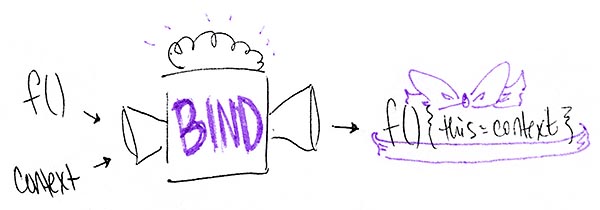Binding and Currying Functions with Javascript
The function bind is a standard part of the JavaScript repertoire, so understanding how it works and being able to re-implement it in a pinch is a good trick for a developer to have up his or her sleeve. In this post, I’ll explore basic context binding as well as supplying extra arguments to the bound function at various points along the way.
The typical completely unrealistic use case looks something like the following:
var englishWords = {greeting: "Hello"}
var sayHello = function(name){
console.log(this.greeting + " " + name);
}
sayHello('world') // -> "undefined world"
englishWords.sayHello('world') // -> error: englishWords.sayHello is not a function
We have a function we can use to say hello to some passed in string, and a (very small) dictionary of English words. Unfortunately, we can’t use the two together because sayHello is looking for some sort of this context to execute in, but englishWords doesn’t actually have a sayHello method, so some sort of middleman is needed.
This is where bind comes in.

That seems fairly straightforward. Let’s write a basic binding function! We’ll take in the function and a context, and return a function that uses that context. With this new function, we should be able to successfully call our sayHello function in the context of englishWords. In fact this will be super useful anywhere we need to use a function somewhere that its context is likely to be lost.
var bind = function(func, context){
return function(){
return func.apply(context);
}
};
Great! Bind will now return a function that runs our function in our context. But we don’t really have any way to deal with other arguments… what if we need to call our function in a context and pass in arguments? We’ll have to grab the arguments that are passed in at calltime and apply them along with the context. We can just nab the arguments object, convert it into a real array, and pass it along.
But wait! Won’t arguments refer to the arguments passed into bind? Turns out that won’t be the case. Thanks to the wonders of scoping, if we use arguments within the function that is returned (but not invoked!) by calling bind, we will be capturing the arguments passed in at calltime for that returned function.
var bind = function(func, context){
return function(){
var calltimeArgs = Array.prototype.slice.call(arguments);
return func.apply(context, calltimeArgs);
}
};
Awesome. But… what if I want to pre-select some arguments when I initially call bind? Perhaps I have some other arguments that will always be the same when used with this specific context. In this case, I’ll want to capture any arguments passed in to my bind function after the function and the context. Enter arguments… again. This time we’ll ask for arguments in the outer function scope to collect the arguments passed to bind, and then convert arguments into a real array and slice off the first two values (we already know that those are our function and our context). Then we can store the rest of the arguments on a variable and pass them in before the calltime arguments.
var bind = function(func, context){
var args = Array.prototype.slice.call(arguments, 2)
return function(){
var calltimeArgs = Array.prototype.slice.call(arguments);
return func.apply(context, args.concat(calltimeArgs));
}
};
Excellent! Our bind function, for the purposes of this blog post, is done! Bonus step: if we wanted to attach it as a method of the prototype of the Function object (for academic curiosity or polyfill purposes) we could. The only extra step is saving the context that bind was called in (the function object that we are calling the bind method on) and making sure that we save it on a variable for later out-of-context use.
Function.prototype.bind = function(context) {
var func = this;
var args = Array.prototype.slice.call(arguments, 1)
return function(){
var calltimeArgs = Array.prototype.slice.call(arguments);
return func.apply(context, args.concat(calltimeArgs));
}
};
And that’s it!
